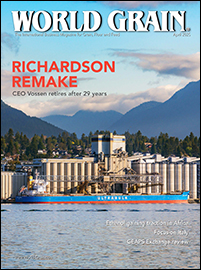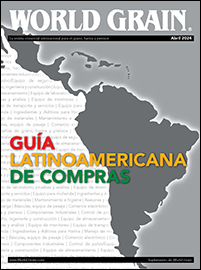Photo courtesy of Bühler.
 |
| Matt Kelly, managing director of Digital Technologies at Bühler |
“Advances in digital technology, together with our sorting and food safety expertise, make this an unrivalled system that contributes to solving a major global food safety and security challenge,” said Matt Kelly, managing director of Digital Technologies at Bühler.
According to Bühler, maize is a vital, staple food crop in many regions of the world and a major component in animal feed, but it is particularly prone to aflatoxin contamination. Aflatoxin is classified as a primary human carcinogen by the International Agency for Research on Cancer. Approximately 500 million people worldwide are at risk of exposure to it and it is estimated to cause up to 155,000 cases of liver cancer every year and contribute to stunting the growth of millions of children.
“Aflatoxin is one of the biggest global pains today,” said Beatrice Conde-Petit, food safety officer for Bühler. “Climate change means that the problem is growing, so eliminating contaminated grains from the food chain more effectively, with less loss of healthy grain, is an urgent challenge.”
Until now sorting maize for aflatoxin reduction has proved difficult and imprecise, relying on identifying indirect indications of contamination. Testing for contamination based on sampling is inconclusive and time-consuming as contamination occurs in hotspots. Just two contaminated kernels in 10,000 are sufficient to make a lot unfit for purpose. Alongside health risks, the economic impact on farmers and food processors is significant.
LumoVision is the first optical sorting technology able to identify aflatoxin based on direct indicators of contamination, while simultaneously using real-time, cloud-based data to monitor and analyze contamination risk, Bühler said.
It works by analyzing the color each kernel fluoresces as it passes under powerful UV lighting in the sorter. It is known that contaminated kernels fluoresce a specific bright green color. LumoVision’s proprietary, highly sensitive cameras detect precisely this color of fluorescence. Within milliseconds of detection, air nozzles deploy to blow contaminated kernels out of the product stream. The machine processes up to 15 tons of product an hour, eliminating up to 90% of contamination.
A cloud-based solution using infrastructure provided by Microsoft is a key enabler to reducing overall yield loss. Combining data from the cameras with data stored in the cloud allows a local, real-time analysis of the risk of contamination to be carried out. When the risk is minimal, sorting is halted while the machine continues to monitor. If the risk rises, sorting automatically restarts. LumoVision, coupled with the cloud service, reduces yield loss to below 5%, compared with between 5% and up to 25% for other current solutions.
 |
| Ben Deefholts, senior research engineer for Digital Technologies at Bühler |
“We are incredibly excited about this achievement,” said Ben Deefholts, senior research engineer for Digital Technologies at Bühler. “As an organization we have strived to solve the problem of aflatoxin contamination for many years. Now, with today’s technological advances we’re able to bring this ground-breaking solution to market. With data science techniques and tools we can develop sorting algorithms, while connectivity and IoT solutions allow us to combine our optical sorting with real-time risk models.”
Caglayan Arkan, general manager of Manufacturing & Resources at Microsoft, added, “Bühler has built a truly revolutionary and inspiring piece of technology — not only to the food industry but to the manufacturing industry on so many levels. Bühler’s revolutionary data-driven optical sorting system doesn’t just predict a toxin in a food particle, but it can eliminate it altogether, by tapping into the breadth and scale of Microsoft’s global Azure cloud, which is powerful and meaningful to keeping all of us safer and healthy.”
With LumoVision, food, feed, and pet food manufacturers can protect their product from contamination, avoid the cost of expensive recalls and reputational consequences, while increasing yields and reducing waste. Grain handlers can upgrade the quality of their product to attract higher prices. However, it is in regions of the world where there is no food safety regulation or where low resource communities have little choice but to eat contaminated food or go hungry, that LumoVision can have an even bigger impact, saving lives and improving livelihoods.
LumoVision is currently undergoing testing onsite with Bühler customer Capa Cologna, Italy, an agricultural cooperative whose maize was affected by aflatoxin after drought conditions during the growing season in 2012. Further testing will take place within the MycoKey network, a project funded by the European Commission to develop smart, sustainable solutions that reduce mycotoxins in food and feed.






